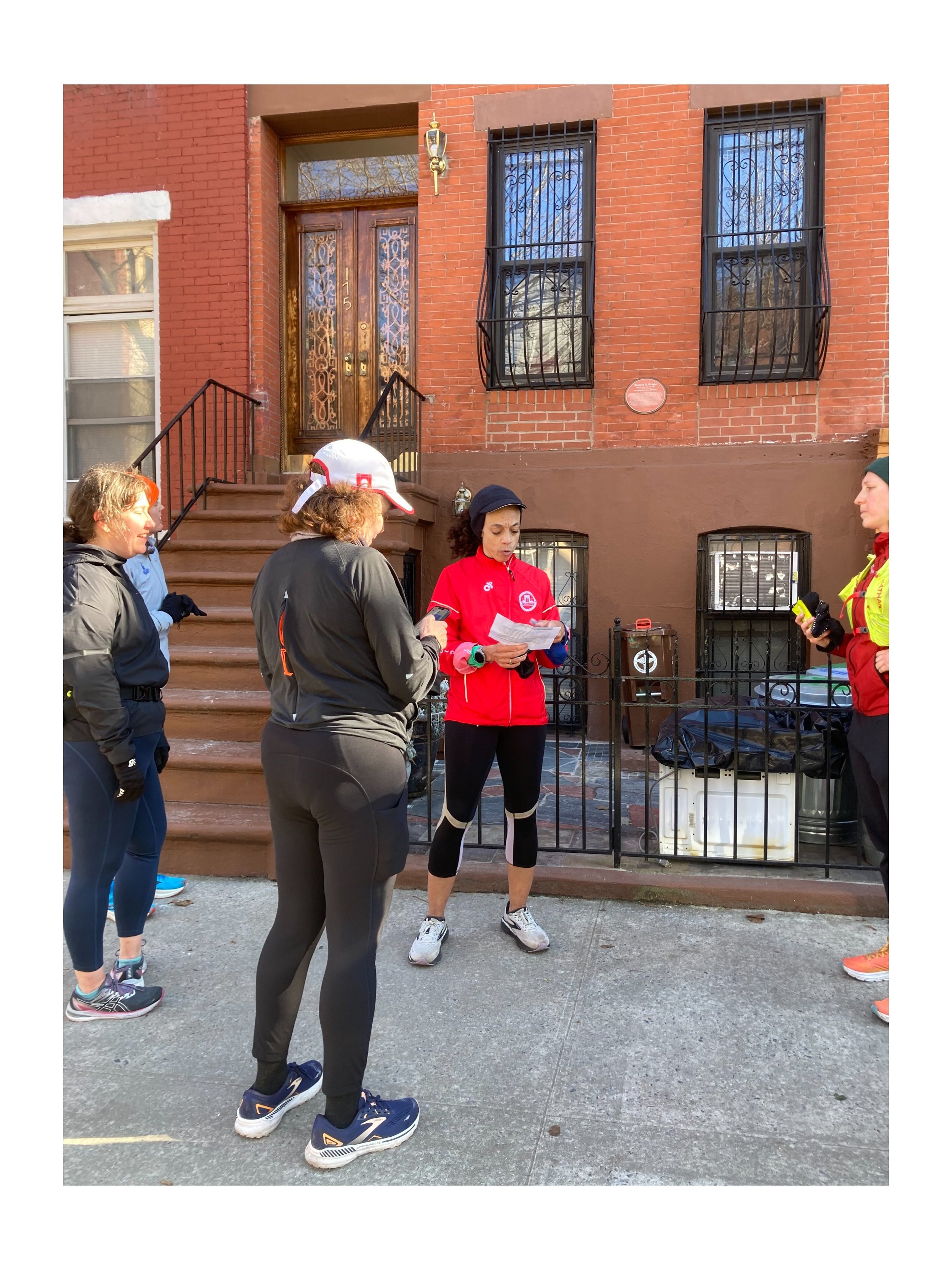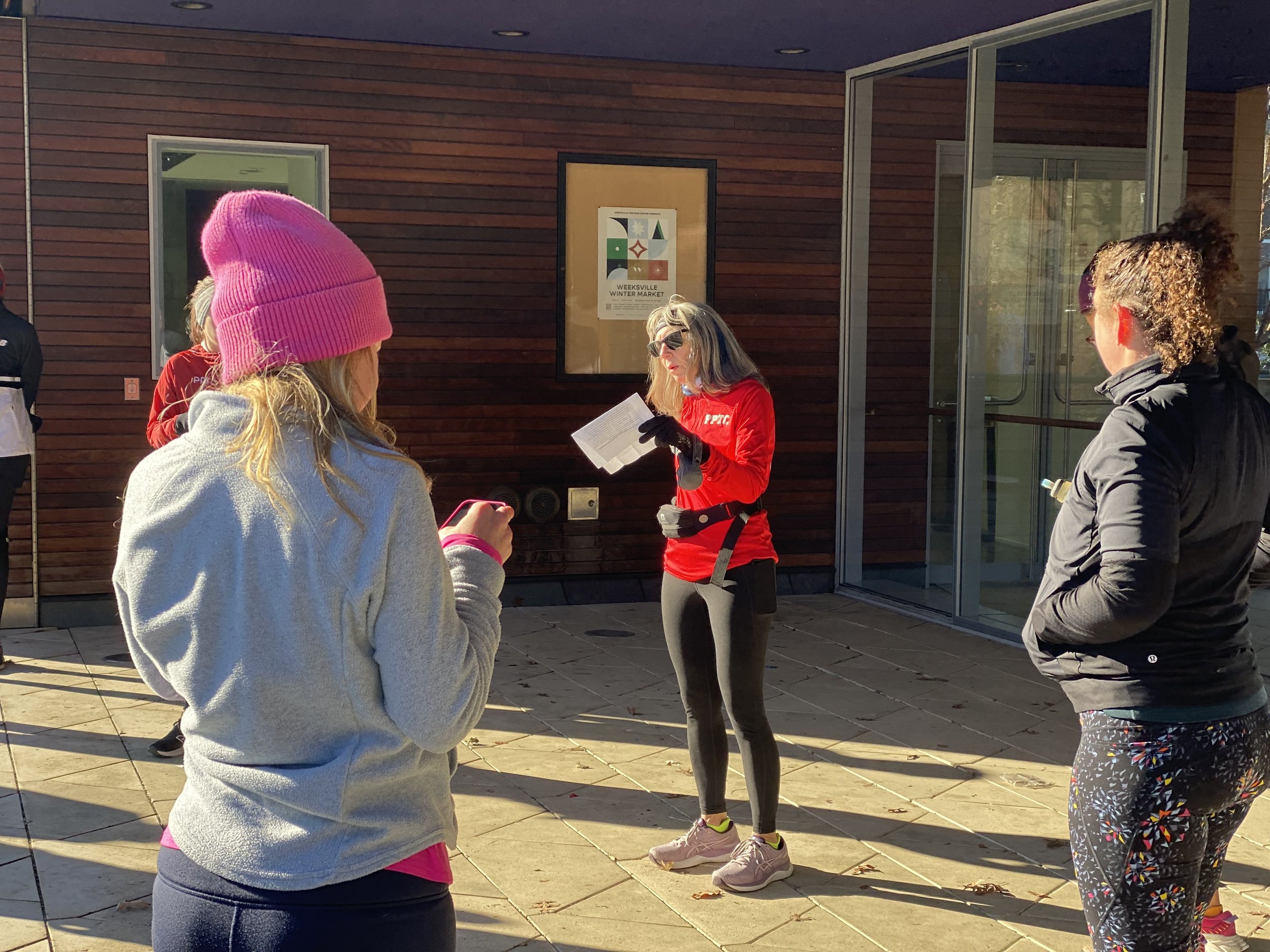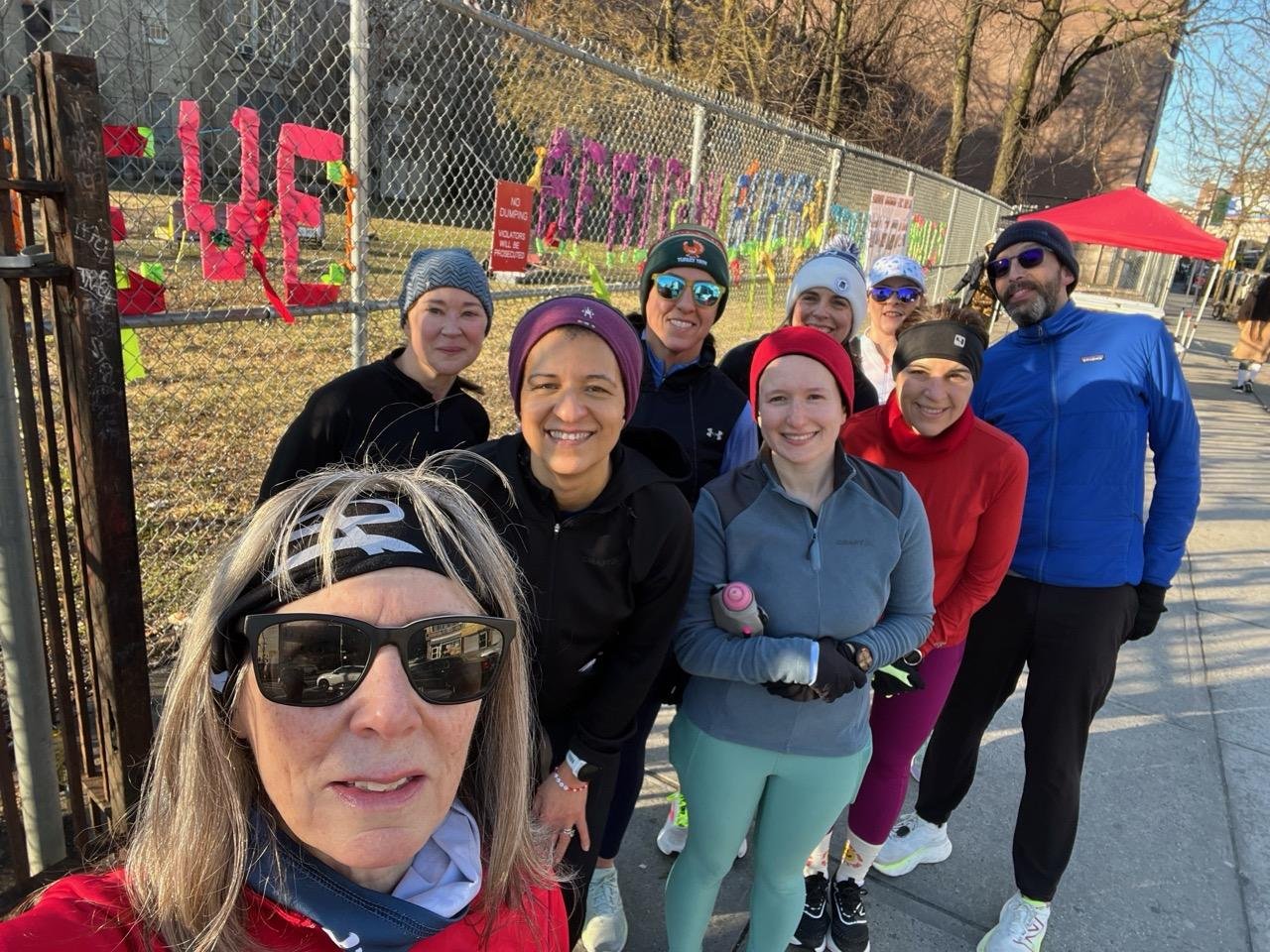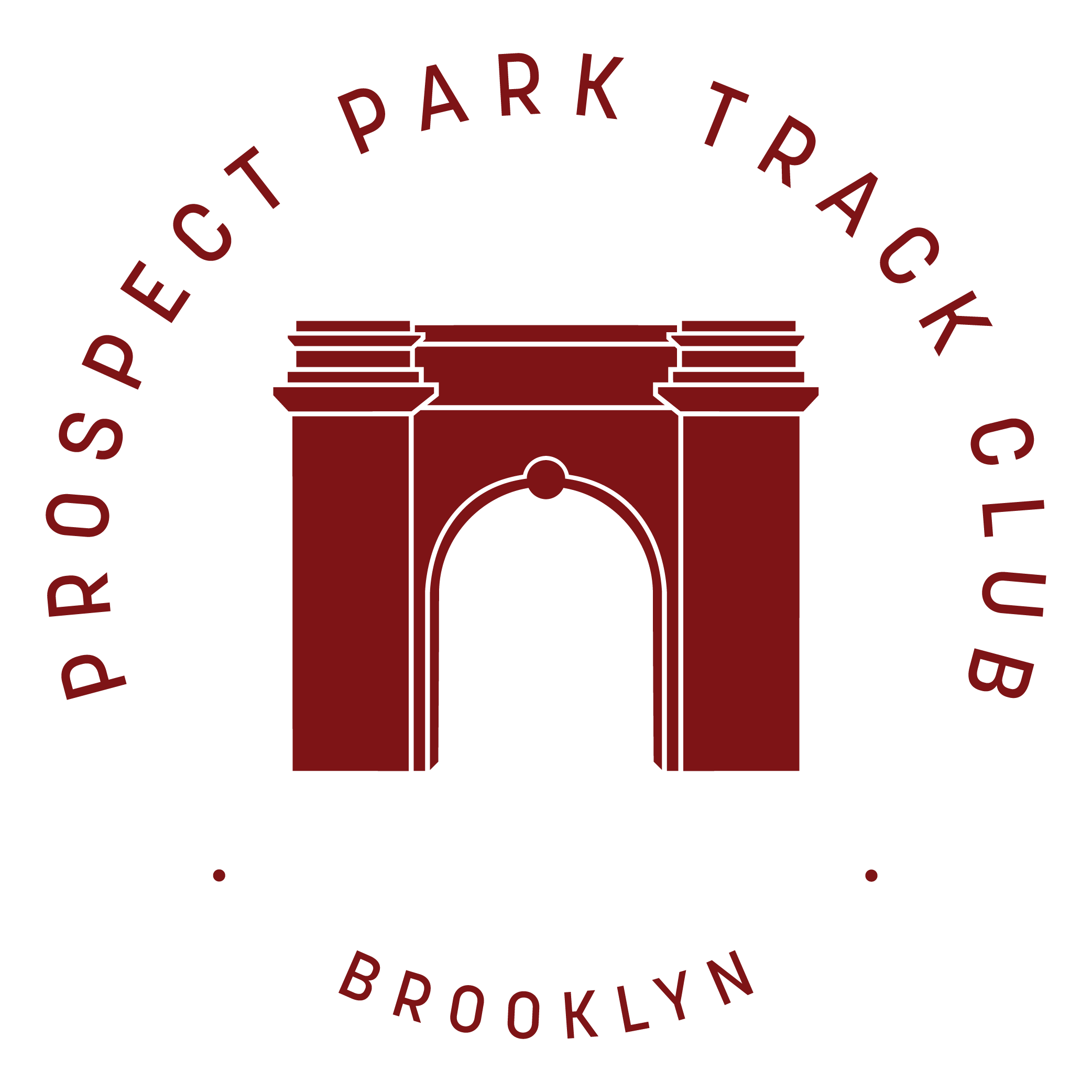PPTC’s 2024 Black History Month No-Drop Run
The 140+ participants for the Black History Month Run on February 3, 2024 at Bartel-Pritchard Square.
Photo by Joy Liu
Co-Led and Written by Karen Thomson and Liza Bowers
Happy Black History Month! PPTC held its second annual Black History Month Run on Saturday, February 3, 2024. Like last year, it was also a no-drop run, with pacers available so that no runner would be left behind. This was apropos, since Black History Month is about being inclusive of all people, by celebrating the contributions of people of the African diaspora to the United States. We were thrilled that morning to have over 140 participants, including a few who joined us along the route – even though the run was the day before NYRR’s Manhattan 10K.
A Brief History of Black History Month
Black History Month evolved from Negro History Week, which was founded by in 1926 by Carter G. Woodson. An historian and educator whose parents had been enslaved, Woodson was the second African American to earn a Ph.D. from Harvard, which he completed in 1918. W.E.B. DuBois had earned the first in 1895. Dr. Woodson recognized the lack of information about the accomplishments of Black people and wanted to “promote, research, preserve, interpret and disseminate information about Black life, history and culture to the global community”.[1]
As a club that celebrates diversity, equity, and inclusion, it is important that we recognize all cultures. This is especially true as we are living in a time when education and teaching about Black culture and other cultures are under attack. Only by learning about each other can we uplift, respect, and value each other.
Organizers of the Run
Edith Asibey organized the pace groups and helped publicize the event. We also had support from Mayna Legoute, who co-led 2023’s run, and Alexis Gordon printed 25 copies of our 2-sided description of the sites and shared her enthusiastic knowledge as a local teacher. The pacers were Crystal Cun, Maureen Keleher, Ellen Alperin, Edith, Janice Fuld, Alex Gordon, Karen, and Lisa M. Knauer.
The Route
The route to the sites was nine miles, plus three for runners returning to Bartel-Pritchard Square. Each site this year was within Brooklyn and represents history that members of New York’s African American community, sometimes including family members of those who lived, worked, or were buried there, have worked to have recognized and preserved.
The route contained residential locations, so we reminded runners that residents might not want visitors taking photos of their homes, staring, or talking loudly outside their windows on a Saturday morning.
Sites Explored
1st Stop: Flatbush African Burial Ground
2286 Church Ave at Bedford Ave, 11226
The group convening at the Flatbush African Burial Grounds.
Photo by Barbara Foley
Records and archaeological research indicate that the African burial ground at this site was in use as early as the 1700s and perhaps as late as 1840, created for people enslaved by white congregants of the Flatbush Dutch Reformed Church, which we passed one block before this one, and for which Church Ave is named. The church was founded in 1654, built in 1662, and was the first church in the Dutch settlement of Flatbush, in unceded territory of Lenape people, the Canarsee. The church and its adjacent graveyard are still there. In contrast, the burial ground where people enslaved by church members were buried was not preserved. Instead, roads and schools were built upon it. Enslaved people had been allowed to worship in the church but required to sit on its balcony. When knowledge of the African burial ground became publicly available in the 21st century, community residents blocked city plans for an affordable housing complex on the site. The lot is now under the auspices of the NYC Parks Department. Its future is undetermined.
Members gathered around the Ebbets Field Home Plate marker for Jackie Robinson.
Photo by Donna Newton
A flier from 1953 the Fight for Freedom against Jim Crow Laws at Ebbets Field.
Photo by Alexis Gordon
2nd Stop: Ebbets Field Home Plate Marker
69 Sullivan Place, 11225 (½ block west of Bedford Ave)
Jackie Robinson integrated Major League Baseball when he joined the Brooklyn Dodgers in 1947. This apartment complex shares the name of the Brooklyn Dodgers’ stadium, Ebbets Field, because the stadium was located here. Recruited from the Negro Leagues, Robinson was picked both for his talent and his character. Mr. Robinson and the Brooklyn Dodgers anticipated that he would face horrible treatment as the first Black player in the Major Leagues. The marker here is modest, but the new Jackie Robinson Museum in Manhattan celebrates his outstanding career in baseball and his broader legacy. As a Dodger he was the league’s Rookie of the Year and MVP, hit 141 home runs, and led his team to a World Series. Off the field his many accomplishments include co-founding the Freedom National Bank of Harlem, speaking at the March on Washington, active involvement in the NAACP, a syndicated column at the Amsterdam News and NY Post, founding a construction company as a means of employing African Americans, first Black VP in a Fortune 500 Company, and role model for many.
The Carlos Lezama Archives at Rep. Shirley Chisholm former home and presidential campaign headquarters.
Photo by Mayna Solange Legoute
3rd Stop: Former Home and Presidential Campaign Headquarters of Rep. Shirley Chisholm
1028 St. Johns Place, 11213 (between Brooklyn and Kingston Aves.)
Elected to Congress in 1968, Shirley Chisholm was the first Black woman in Congress, where she represented Bedford-Stuyvesant and Crown Heights until 1983. In 1972, she became the first female and first African American candidate for a major party’s nomination for President. Her campaign slogan, “Unbought and Unbossed,” are words used to describe her legacy. She is quoted as saying, “If they do not give you a seat at the table, bring a folding chair.” Born in Brooklyn in 1924 to parents who were part of the first wave of Caribbean immigration to NY, she was a graduate of Girls High School, Brooklyn College, and Teachers College at Columbia University. Chisholm lived in several locations in this neighborhood. The address currently houses the Carlos Lezama Archives and Caribbean Cultural Center. Lezama was one of the founders of Brooklyn’s West Indian Day Parade.
The plaque for Hunterfly Road Houses in Weeksville.
Photo by Mayna Solange Legoute
4th Stop: Weeksville Heritage Center
158 Buffalo Ave, 11213 (between St. Marks Ave & Bergen St)
Before the Civil War, Weeksville was one of the largest free Black communities in the U.S. The Weeksville Heritage Center has restored three of the houses from the 1860s, 1930s, and 1900s on what was then Hunterfly Rd. Before becoming Hunterfly Rd in the colonial era, the route had been a Native American trail alongside a creek. The modern building at 158 Buffalo Ave uses education, the arts and a social justice lens to document and inspire engagement with Weeksville’s history. Our run wasn’t during tour hours, so we suggest returning to see more.
5th Stop: Former Home of Richard Wright
175 Carlton Ave, 11205 (between Willoughby & Myrtle Aves.)
The crew at stop 5 :)
Photo by Donna Newton
Richard Wright, an American novelist is often associated with Chicago, or perhaps with his chronicle of his own childhood in Mississippi (Black Boy, 1945) – but while writing his most famous novel, Native Son, published in 1940, he resided here. Wright moved to the apartment in 1938 and is said to have spent much of his time writing the book on a bench in Fort Greene Park. The words on an historic marker on the house are difficult to read without standing beside it, so we printed them in advance.






Learn More About These Sites:
The Flatbush African Burial Ground:
https://www.flatbushafricanburialground.org/
https://www.nyc.gov/site/hpd/services-and-information/fabg-site-history.page
The Dutch Reformed Church: OG Flatbush Landmark — Flatbush History
Former Home and Presidential Campaign Headquarters of Rep. Shirley Chisholm: https://www.brooklyn.edu/wgst/chisholm/ www.brownstoner.com/history/shirley-chisholm-brooklyn-walking-tour-architecture-crown-heights-bed-stuy-black-history-congress/
Former Home of Richard Wright: https://myrtleavenue.org/introducing-richard-wright-way/
Other Resources: https://www.bklynlibrary.org/cbh/collections/research-guides/african-american-history Includes information about property records of early White residents. Many whose ownership of slaves is included are surnames recognizable from street names and landmarks we see in Brooklyn.
Written by: Karen Thomson (she/her) and Liza Bowers (she/her)
Edited by: Edith Asibey
Photos by: Joy Liu, Barbara Foley, Donna Newton, Mayna Solange Legoute, Alexis Gordon, and Lisa Mayer Knauer
Produced by: Rachael DePalma (she/her)
PPTC is a diverse and supportive team. We want to celebrate the diversity of our club and membership. We welcome and encourage everyone to share their stories with us.







